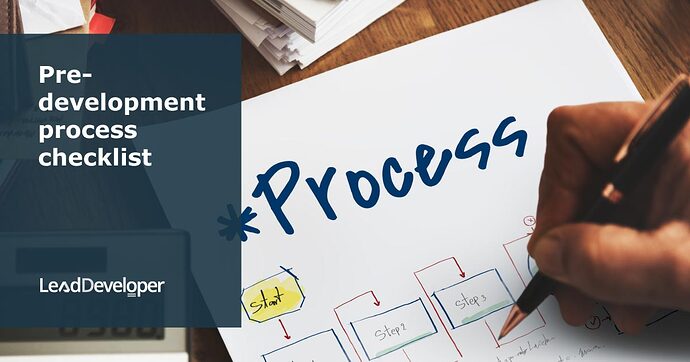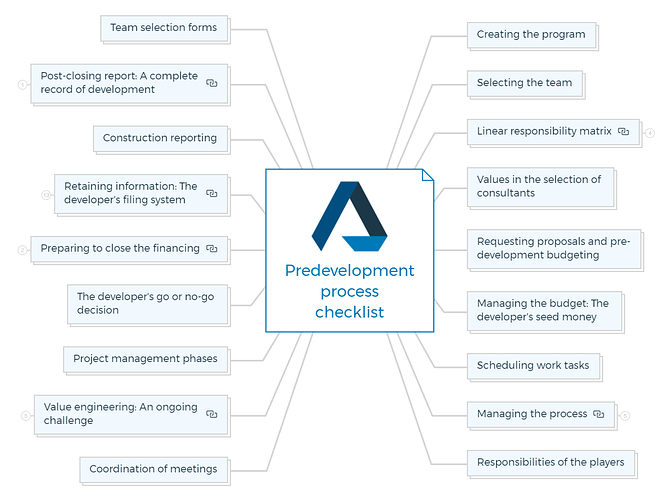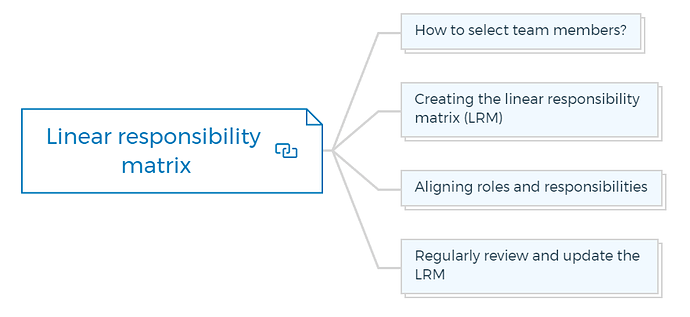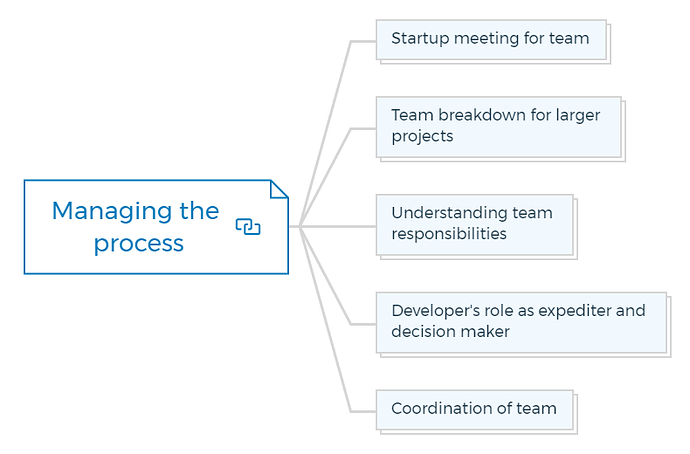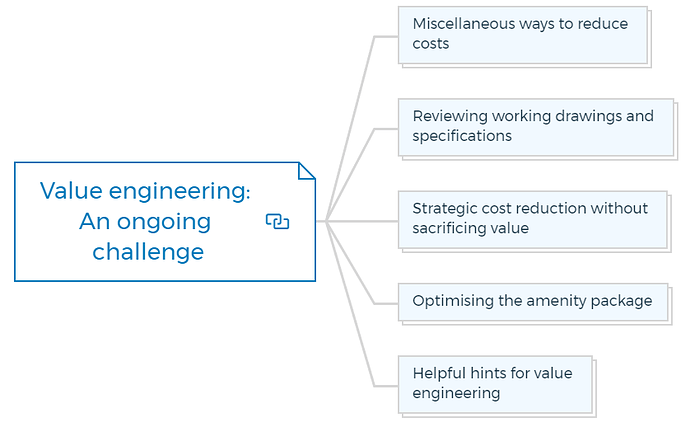1. Creating the program
- Define the project’s goals, objectives, and scope.
- Identify the target market and end users.
- Determine the project’s size, scale, and features.
- Develop a clear vision and mission statement for the project.
2. Selecting the team
- Identify key stakeholders, including internal and external team members.
- Formulate a selection committee responsible for choosing team members.
- Evaluate potential team members’ expertise, experience, and compatibility.
- Assign roles and responsibilities to each team member.
Learn More
3. Linear responsibility matrix
- Create a linear responsibility matrix (LRM) to define roles and responsibilities.
- Outline who is accountable, responsible, consulted, and informed for each task or phase.
- Ensure the LRM is understood and agreed upon by all team members.
3.1. How to select team members?
- Define the criteria for selecting team members, considering their skills, experience, and compatibility with the project.
- Evaluate potential team members based on their expertise in relevant areas.
- Consider diversity and different perspectives to ensure a well-rounded team.
- Conduct interviews or assessments to gauge candidates’ suitability for their respective roles.
- Collaborate with key stakeholders to make informed decisions about team composition.
3.2. Creating the linear responsibility matrix (LRM)
- Develop a clear and comprehensive LRM that outlines roles and responsibilities for each team member.
- Specify who is accountable, responsible, consulted, and informed for each task or phase.
- Ensure that the LRM reflects the project’s hierarchy and reporting structure.
- Share the LRM with the entire team to ensure everyone understands their roles.
3.3. Aligning roles and responsibilities
- Review the LRM to ensure roles are well-defined and aligned with project goals.
- Avoid ambiguity in task ownership to prevent confusion during project execution.
- Assign roles based on individuals’ strengths and expertise, maximising their contributions.
- Clearly communicate expectations to team members about their responsibilities.
3.4. Regularly review and update the LRM
- Continuously assess the effectiveness of the LRM throughout the predevelopment process.
- Update the matrix if team composition changes or project requirements evolve.
- Collaborate with team members to gather feedback on the clarity and accuracy of the LRM.
- Use the LRM as a reference for managing tasks, resolving conflicts, and tracking progress.
You are missing out if you haven’t yet subscribed to our YouTube channel.
4. Values in the selection of consultants
- Define selection criteria for consultants, considering their expertise, reputation, and alignment with project goals.
- Conduct interviews and reference checks to ensure consultants’ suitability.
- Emphasise values such as collaboration, innovation, and transparency in consultant selection.
5. Requesting proposals and pre-development budgeting
- Prepare a comprehensive Request for Proposal (RFP) for necessary consultants.
- Include detailed project information, scope of work, and submission guidelines in the RFP.
- Develop a predevelopment budget that covers the initial planning and design phases.
Learn More
6. Managing the budget: The developer’s seed money
- Allocate seed money for initial project activities like feasibility studies and concept development.
- Track and manage expenses within the predevelopment budget.
- Establish a process for requesting additional funds if needed.
7. Scheduling work tasks
- Develop a detailed project schedule that outlines key milestones and deadlines.
- Sequence tasks logically to ensure a smooth progression from concept to development.
- Account for dependencies, potential delays, and critical path activities.
8. Managing the process
8.1. Startup meeting for team
- Hold a team-wide startup meeting after budget approval, team selection, and scheduling of work tasks.
- Review the project’s program and goals in this meeting.
- Establish regular coordination meetings for ongoing communication.
- Build relationships and open channels for effective communication.
- Address any initial questions and concerns.
8.2. Team breakdown for larger projects
- Consider breaking the team into smaller groups based on functions (e.g., design, construction, marketing).
- Especially useful for larger projects to enhance management efficiency.
8.3. Understanding team responsibilities
- As the leader (developer), understand each team member’s responsibilities thoroughly.
- This understanding helps in effective delegation and decision-making.
- Developer’s role shifts to being an expediter and decision-maker once the team is in action.
8.4. Developer’s role as expediter and decision maker
- After team formation, the developer takes on the role of expediting tasks and making key decisions.
- A deep understanding of the team enables smoother workflow and fewer problems.
8.5. Coordination of team
- Coordinate different team members and groups for seamless collaboration.
- Regularly scheduled coordination meetings facilitate communication and progress tracking.
9. Responsibilities of the players
- Clearly define the responsibilities of each team member and consultant.
- Ensure that all parties understand their roles and contributions.
- Foster a collaborative environment to encourage effective teamwork.
10. Coordination of meetings
- Schedule regular team meetings to discuss progress, challenges, and next steps.
- Utilise technology for virtual meetings if team members are located remotely.
- Set an agenda for each meeting and distribute relevant materials in advance.
11. Value engineering: An ongoing challenge
- Incorporate value engineering practices to optimise project outcomes.
- Encourage continuous evaluation of design and functionality for cost-effectiveness.
- Balance value engineering with maintaining project quality and objectives.
11.1. Miscellaneous ways to reduce costs
Explore various avenues to cut costs without compromising quality.
- Reduce the amount of site work.
- Check on the safety factor of the structure.
- Reduce the amount of glass.
- Reduce costs in the construction of the interior of the building.
11.2. Reviewing working drawings and specifications
- Conduct a thorough review of working drawings and specifications.
- Look for opportunities to optimise designs and materials for cost-effectiveness.
11.3. Strategic cost reduction without sacrificing value
- Determine areas where costs can be reduced while maintaining project value.
- Avoid undermining the overall quality and functionality of the project.
11.4. Optimising the amenity package
- Evaluate the amenity package offered to end users.
- Determine if adjustments can be made to enhance perceived value without inflating costs.
11.5. Helpful hints for value engineering
- Collaborate with the team to brainstorm cost-saving ideas.
- Encourage open discussions about potential improvements.
- Consider input from various disciplines for comprehensive solutions.
12. Project management phases
- Divide the predevelopment process into clear phases (feasibility, concept, planning, etc.).
- Define deliverables, objectives, and success criteria for each phase.
- Use phase gates to review progress before advancing to the next phase.
There are 4 major phases of development that the construction project manager will need -
- Predevelopment phase
- Design phase
- Construction phase
- Delay claims analysis phase
13. The developer’s go or no-go decision
- Conduct a thorough review after each phase to determine whether to proceed.
- Evaluate project viability, financial feasibility, and alignment with strategic goals.
- Make informed decisions based on well-defined criteria.
14. Preparing to close the financing
- Evaluate potential financing options for the project’s development phase.
- Develop a financing strategy that aligns with the project’s timeline and needs.
- Prepare necessary documentation for securing financing.
14.1. Attorney
- Engage legal experts to review and finalize financing agreements.
- Ensure all legal documents are accurate, compliant and protect the developer’s interests.
- Collaborate with attorneys to address any legal concerns and negotiate favourable terms.
14.2. Marketing
- Develop a comprehensive marketing strategy to attract potential investors or lenders.
- Highlight the project’s value proposition, benefits, and potential returns.
- Prepare marketing materials, presentations, and pitches to showcase the project’s viability.
Remember, involving experts in law and marketing during the financing preparation stage enhances the project’s credibility and increases the likelihood of securing the necessary funds.
15. Retaining information: The developer’s filing system
- Establish a structured filing system to store and organise project-related documents.
- Ensure easy accessibility for team members and stakeholders.
- Regularly update the filing system with new information.
15.1. Development
- Keep a record of the project’s overall development strategy and milestones.
15.2. Land acquisition
- Document details of land purchase agreements, negotiations, and terms.
Learn More
15.3. Design and engineering
- Retain architectural and engineering plans, revisions, and design decisions.
15.4. General contractor
- Maintain records of contractor selection, contracts, progress reports, and payments.
15.5. Agreements
- Archive all project-related agreements, contracts, and legal documentation.
15.6. Marketing
- Store marketing materials, advertising strategies, and customer engagement records.
15.7. Financing
- Keep records of financing agreements, terms, and payment schedules.
15.8. Equity partner
- Document agreements and communications with equity partners or investors.
15.9. Property management
- Maintain property management agreements, operational plans, and performance reports.
15.10. Accounting
- Organize financial records, budgets, expenditures, and income statements.
15.11. Legal
- Keep copies of legal documents, permits, licenses, and regulatory approvals.
15.12. Unit closing
- Store documentation related to unit sales, closings, and occupancy agreements.
15.13. Sale
- Keep records of the sale process, negotiations, and final sale agreements.
16. Construction reporting
- Develop a reporting process to track construction progress and milestones.
- Implement regular site visits and reporting mechanisms to monitor construction quality.
- Address any issues or deviations promptly to avoid delays.
17. Post-closing report: A complete record of development
- Compile a comprehensive post-closing report detailing the entire predevelopment process.
- Include lessons learned, challenges overcome, and areas for improvement.
- Use the report as a reference for future projects.
17.1. Post-closing development memorandum outline
- Overview of the deal
- Banking information
- Tax identification number
- Investor call for funds
- Debt service payment instructions
- Real estate tax escrow
- Insurance escrow
- Reporting requirements
- Partnership service fees
- Deposits
- Service contracts
- Inventory
- Builder warranties
- Subcontractors information
- Material identification
- Operating manuals
- Seller warranties
- Closing statement
- Reconciliation of purchaser closing costs
- Completion certification letter from lender
- Lien waiver release at closing
- Construction penalty computation
- Copies of all certificates of occupancy
- Date tickler file
- Copy of investor information package
18. Team selection forms
- Create standardised forms for documenting the selection process of consultants and team members.
- Record evaluation criteria, interview notes, and final selection decisions.
- Maintain a record of team selection for reference and transparency.
By following this checklist, you can effectively navigate the predevelopment process, ensuring proper planning, coordination, and execution of your project.
